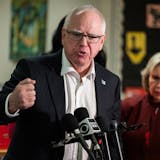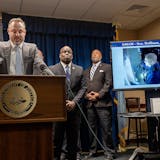The contractor building the $2.7 billion Southwest light-rail line attributes many of its cost overruns and delays to a "deficient design" crafted long before ground was broken on the project nearly five years ago.
In documents obtained by the Star Tribune through the state's Data Practices Act, officials with Lunda McCrossan Joint Venture (LMJV) also take aim at the state's Office of the Legislative Auditor, calling its critical reports on the project "inaccurately reported or incorrectly interpreted" and "lacking any apparent experience or expertise."
The legislative auditor has "either misrepresented the facts or twisted them to serve an objective," wrote Dennis Behnke, CEO of Wisconsin-based Lunda Construction Co., in a March 29 letter to Metropolitan Council Chair Charlie Zelle.
LMJV largely has refrained from commenting publicly on Southwest's issues since it was awarded the $800 million civil construction bid in 2018.
Legislative Auditor Judy Randall declined to comment on the LMJV documents. Two additional reports on the project from her office are expected by the end of the year.
The Met Council is overseeing construction of the 14.5-mile line, which will connect downtown Minneapolis and Eden Prairie through St. Louis Park, Hopkins and Minnetonka once it begins service in 2027. The extension of the current Green Line is more than 70% complete.
Southwest is an enormously complicated infrastructure project, one the Met Council calls a "generational investment." It includes 16 new stations, 29 bridges and two light-rail tunnels, including one in Minneapolis' narrow and densely populated Kenilworth Corridor between Cedar Lake and Lake of the Isles.
The project's expanding budget has made it the most expensive public works project in Minnesota history, as well as the focus of growing public disdain. Southwest's original $1.25 billion budget has more than doubled, and its opening date has been pushed back nearly a decade.

![A black bear stopped after crossing Big Bay Road on Madeline Island, the largest of the Apostle Islands in Wisconsin, on Monday, May 31, 2021. ]](https://arc.stimg.co/startribunemedia/PWNYGIY3WTSWDBOGOYD775DPP4.jpg?&w=80&ar=1:1&fit=crop)

